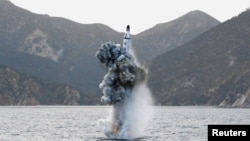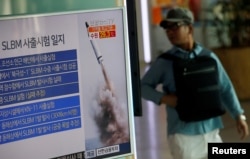North Korea’s submarine-launched ballistic missile test on Wednesday is prompting analysts in Seoul to speculate about what might have motivated Pyongyang to conduct it.
The missile flew 500 kilometers, an apparent leap forward for Pyongyang's technical efforts to achieve SLBM capability, which it has been pursuing since early 2015.
Kim Jin-moo, a senior research fellow at the Korea Institute for Defense Analyses, said the North’s SLBM program might be more advanced than previously thought, and that Pyongyang could be SLBM-capable within a year. The analyst cautioned, however, that whether the North will be able to mount a nuclear warhead on the missile remained to be seen.
Moon Sung-muk of the Korea Research Institute for Strategy in Seoul said Pyongyang's lack of large submarines meant the regime might be years away from acquiring full SLBM capability.
Wednesday's launch came two days after U.S.-South Korean annual military drills kicked off.
Chang Yong-seok of Seoul National University’s Institute for Peace and Unification Studies perceived Wednesday's test as Pyongyang’s attempt to dismiss speculation about regime stability following a series of high-profile defections by North Korean officials.
Last week, South Korea announced that North Korea’s deputy ambassador in London defected to the South. South Korean President Park Geun-hye warned of possible North Korean provocations this week, calling the latest defection a “serious fracture” within the North Korean regime.
“The test is aimed at rallying internal support for the regime by creating a message that the country has the ability to defend against possible attacks from the U.S. or South Korea,” said Chang.
Defense system plans
Some tied the test to South Korea’s plan to deploy Terminal High Altitude Area Defense (THAAD), an advanced U.S. missile defense system, which has sparked controversy in the South. Seoul insists that the system is needed to counter Pyongyang’s missile threats. Critics question the missile defense system’s ability to cope with the North Korean threats, and they cite possible health risks that the system might pose.
“The North is trying to stir up divisions in the South over the deployment,” said Koh Yu-hwan, a professor at Dongguk University in Seoul.
Koh said the missile defense system has a limited defense capability against an SLBM and the North is trying to turn it into controversy.
The United States condemned Wednesday's test, again accusing Pyongyang of violating U.N. resolutions.
“We strongly condemn this and North Korea’s other recent missile tests, which violate multiple U.N. Security Council resolutions explicitly prohibiting North Korea’s launches using ballistic missile technology,” Justine Higgins, a spokeswoman for the U.S. State Department's Bureau of East Asian and Pacific Affairs, told VOA by email.
Baik Sungwon in Washington contributed to this report, which was produced in collaboration with VOA's Korean service.







